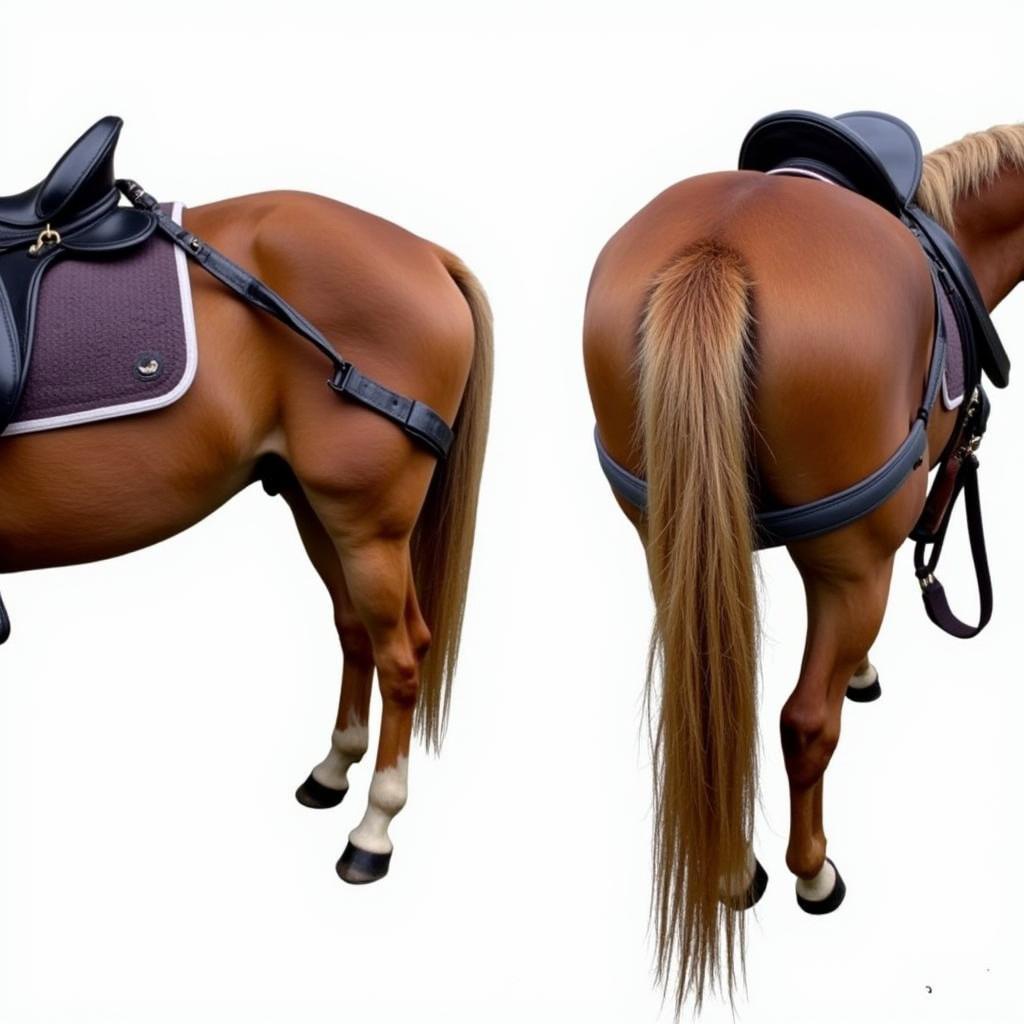A Crupper For Horses is a piece of tack that plays a crucial role in ensuring the saddle’s stability and the rider’s safety. While it might appear as a simple strap, its purpose is essential for certain riding disciplines and situations.
 Horse Wearing a Crupper While Riding
Horse Wearing a Crupper While Riding
What is a Crupper for Horses?
In essence, a crupper for horses is a strap or harness component that helps prevent the saddle from slipping forward. It attaches to the back of the saddle and loops under the horse’s tail, resting on the dock (the base of the tail). This strategic placement counteracts the forward pressure exerted on the saddle, especially during activities like riding uphill, jumping, or engaging in intense movements.
When is a Crupper Necessary?
While not all horses require a crupper, certain situations make its use beneficial or even essential. Here are instances when a crupper becomes particularly important:
- Horse Conformation: Horses with a forward girth groove or a less defined wither are more prone to saddle slippage. A crupper helps keep the saddle secure and prevents it from sliding forward onto the horse’s shoulders.
- Riding Discipline: Certain disciplines, such as jumping, eventing, and steep trail riding, involve movements that can shift the saddle’s position. A crupper provides added stability and security for both horse and rider.
- Saddle Fit: Even with a well-fitted saddle, factors like weight distribution or the horse’s muscle development can contribute to saddle movement. A crupper acts as an extra measure to ensure a proper saddle fit during riding.
Types of Cruppers
Cruppers come in various materials and designs, each catering to different needs and preferences. Some common types include:
- Leather Cruppers: Known for their durability and traditional appearance, leather cruppers are a popular choice.
- Neoprene or Synthetic Cruppers: Offering a lightweight and easy-to-clean option, neoprene or synthetic cruppers are gaining popularity.
- String Cruppers: Often used in driving harnesses, string cruppers are simple yet effective in preventing harness movement.
Choosing the Right Crupper
Selecting the appropriate crupper for your horse depends on several factors:
- Size and Fit: The crupper should fit comfortably without being too tight or too loose. Measure the distance from the back of the saddle to the base of your horse’s tail to determine the correct size.
- Material: Consider the durability, ease of cleaning, and potential for rubbing when choosing a material. Leather is classic but requires more maintenance, while synthetic options are often more low-maintenance.
- Discipline: The type of riding you engage in influences the design and features you might need. For instance, a crupper with a wider, padded area under the tail might be preferable for jumping.
Using a Crupper Safely
While cruppers offer stability, improper use can cause discomfort or even injury to the horse. Keep these safety tips in mind:
- Gradual Introduction: If your horse is unfamiliar with a crupper, introduce it slowly and gently. Allow them to get accustomed to the feel and movement.
- Proper Adjustment: Ensure the crupper is adjusted correctly to avoid excessive pressure or chafing. The strap should be snug but not overly tight.
- Regular Inspection: Check the crupper regularly for any signs of wear and tear. Replace it if you notice any damage.
Alternatives to Cruppers
If you’re looking for alternatives to a traditional crupper, consider these options:
- Breastplate: A breastplate can help stabilize the saddle from the front, preventing it from slipping backward.
- Non-Slip Saddle Pads: Pads with a non-slip material on the underside can provide additional grip and help reduce saddle movement.
- Correct Saddle Fit: The most crucial factor is a properly fitted saddle. If the saddle fits well, the need for a crupper might be reduced or eliminated.
For further exploration of horse tack and equipment, explore our resources on surcingle for horses and horse harness hardware parts.
Crupper for Horses: Ensuring Comfort and Performance
A crupper, while a seemingly simple piece of equipment, plays a vital role in maintaining saddle stability and rider safety. Understanding its purpose, types, and proper usage ensures both horse and rider can perform at their best. Always prioritize your horse’s comfort and well-being, and consult with a qualified equestrian professional if you have any questions or concerns about using a crupper or any other piece of tack.
Frequently Asked Questions about Cruppers for Horses
1. Are cruppers cruel to horses?
A properly fitted and adjusted crupper should not cause any discomfort or pain to the horse. However, a poorly fitting or misused crupper can lead to rubbing, chafing, or discomfort.
2. Can I use a crupper on all types of saddles?
Cruppers are typically used with English saddles and certain types of trail saddles. They are not usually necessary or recommended for Western saddles.
3. How tight should a crupper be?
A crupper should be snug but not overly tight. You should be able to fit a few fingers comfortably between the crupper and the horse’s tail.
4. Can I use a crupper on a young horse?
It’s best to consult with an experienced trainer or equestrian professional before using a crupper on a young or inexperienced horse.
5. What are some signs that a crupper doesn’t fit properly?
Signs of an ill-fitting crupper include rubbing or hair loss around the tail area, excessive tail swishing, and resistance or discomfort from the horse.
If you’re seeking information about driving harnesses and their components, delve into our detailed guides on horse driving harness parts and draft horse harness parts, offering comprehensive insights into this specialized area of equestrian equipment.
For any assistance or guidance related to horse care, tack, or equestrian pursuits, don’t hesitate to reach out. Contact us at Phone Number: 0772127271, Email: [email protected], or visit our location at QGM2+WX2, Vị Trung, Vị Thuỷ, Hậu Giang, Việt Nam. Our dedicated customer support team is available 24/7 to address your inquiries and provide tailored solutions.